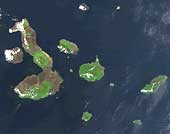|
COMETS EARTH JUPITER KUIPER BELT MARS MERCURY METEORITES NEPTUNE OORT CLOUD PLUTO SATURN SOLAR SYSTEM SPACE SUN URANUS VENUS ORDER PRINTS
PHOTO CATEGORIES SCIENCEVIEWS AMERICAN INDIAN AMPHIBIANS BIRDS BUGS FINE ART FOSSILS THE ISLANDS HISTORICAL PHOTOS MAMMALS OTHER PARKS PLANTS RELIGIOUS REPTILES SCIENCEVIEWS PRINTS
|
Related Documents
Download Options
This true-color image of the Galapagos Islands was acquired on March 12, 2002, by the Moderate-resolution Imaging Spectroradiometer (MODIS), flying aboard NASA's Terra satellite. The Galapagos Islands, which are part of Ecuador, sit in the Pacific Ocean about 1000 km (620 miles) west of South America. The islands sit on the Galapagos rift, an offshoot of the East Pacific Rise. The islands were formed by volcanic eruptions, which took place millions of years ago. The islands straddle the equator in a chain of 13 large island and many smaller ones. They lie between 1° north and 1°3' south, and lies between 89 and 92° west longitude. With the exception Isabella, the islands have high volcanic craters at the island centers, that rise to 1,520 meters and are roughly circular in shape. Unlike most remote islands in the Pacific, the Galapagos have gone relatively untouched by humans over the past few millennia. As a result, many unique species have continued to thrive on the islands. Over 95 percent of the islandsí reptile species and nearly three quarters of its land bird species cannot be found anywhere else in the world. Two of the more well known are the Galapagos giant tortoise and marine iguanas. The unhindered evolutionary development of the islandsí species inspired Charles Darwin to begin The Origin of Species eight years after his visit there. To preserve the unique wildlife on the islands, the Ecuadorian government made the entire archipelago a national park in 1959. Each year roughly 60,000 tourists visit these islands to experience what Darwin did over a century and a half ago. |
